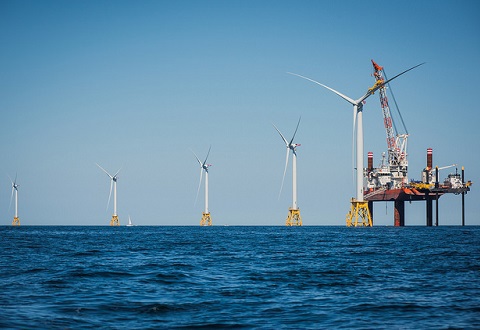Block Island Offshore Wind Farm Set the Stage for Further Clean Energy Development
 In December 2016, Rhode Island became home to North America’s first offshore wind farm with the successful installation and operation of the 30 MW Block Island Wind Farm. This five-turbine project was developed by Deepwater Wind, headquartered in Providence, Rhode Island. It was advanced and developed with the support and active participation of three Governors’ administrations starting in 2007. The project has already received considerable attention, but because of its important role in jump-starting the offshore wind industry in the United States, it is useful to trace the project’s history and detail its impacts.
In December 2016, Rhode Island became home to North America’s first offshore wind farm with the successful installation and operation of the 30 MW Block Island Wind Farm. This five-turbine project was developed by Deepwater Wind, headquartered in Providence, Rhode Island. It was advanced and developed with the support and active participation of three Governors’ administrations starting in 2007. The project has already received considerable attention, but because of its important role in jump-starting the offshore wind industry in the United States, it is useful to trace the project’s history and detail its impacts.
Becoming the First: From Concept to Reality
Rhode Island first began exploring offshore wind development in 2007. In subsequent years, a wide range of parties were involved with the process, including the Rhode Island Office of Energy Resources (OER), other state agencies, federal agencies, fisheries trades, businesses, and the University of Rhode Island (URI).
The Rhode Island General Assembly passed legislation in 2009 and 2010 that enabled the Block Island Offshore Wind Farm to be built through a long-term power purchase agreement (PPA) with National Grid, the state’s investor-owned utility. The PPA guaranteed a buyer for the power from the wind farm and helped secure financing for the project. Before this state law, it was impossible for a PPA to be issued or awarded for offshore wind. Because of the law, Deepwater Wind, the wind farm’s developer, was able to enter into a long-term PPA with National Grid.
The Rhode Island Coastal Resource Management Council (CRMC) and URI developed an Ocean Special Area Management Plan (Ocean SAMP) that was adopted in 2010. The Ocean SAMP and associated research and stakeholder meetings occurred with state agencies (CRMC, Department of Environmental Management), URI, environmental nonprofits, and fisheries trade organizations between 2009 and 2011, and looked at the differing uses of the state waters. This provided a context for evaluating potential offshore wind projects and resulted in the selection of the Block Island wind farm location. It also identified suitable locations for future offshore wind projects in federal waters off of Rhode Island and Massachusetts. The U.S. Department of Interior’s Bureau of Ocean Energy Management has recognized Rhode Island’s Ocean SAMP as a model that other states could emulate.
OER played a variety of important roles in advancing the project between 2007 and 2016. OER worked with the CRMC and URI to secure funds that enabled the Ocean SAMP research to be conducted. OER also worked in coordination with the state’s Department of Transportation and Department of Environmental Management as well as National Grid to determine the location for the submerged transmission cable coming to the mainland from the Block Island Wind Farm.
The Block Island offshore wind project began construction in the summer of 2015 with the installation of the jacket system foundations. The wind turbines (blades, nacelles, towers) were installed in the summer of 2016. The project became commercially operational in December 2016. The town of New Shoreham on Block Island officially turned off its diesel generators in May 2017, becoming the first and only town in North America to be 100 percent powered by offshore wind.
Rhode Island Governor Gina Raimondo remarked that: “Rhode Island is proud to be home to the nation’s first offshore wind farm – and I’m proud to be the only governor in America who can say we have steel in the water and blades spinning over the ocean.”
A Small Project with Large Benefits
Although the Block Island Offshore Wind Farm is small compared to future offshore wind projects that will be installed over the coming decade off the coasts of Northeast and Mid-Atlantic states, it has had big impacts. It is capable of powering about 17,000 homes, or about 1 percent of the state’s electricity. Moreover, the project connected Block Island to the mainland electric grid for the first time, allowing the town of New Shoreham to shut down the diesel-fired power plant that had previously provided electrical power, saving nearly one million gallons of fuel per year and eliminating the need to ship diesel fuel to Block Island. This increased reliability and will reduce electric rates for the town’s ratepayers by an estimated 40 percent. More than 300 local workers were involved with building the wind farm and Deepwater Wind used four Rhode Island ports – Block Island, Galilee, Quonset Point and ProvPort – to complete construction and staging.
The Block Island Offshore Wind Farm showed that it is possible to build an offshore wind project in the United States. The publicity it has received after it went online, its popularity with a wide range of stakeholders, and the opportunity it has given people to visit an operating offshore wind project have all helped create momentum behind further offshore wind development.
Other states are now following Rhode Island’s lead. To help those states, OER has shared information about its experiences with the Block Island project and has passed along lessons learned. The Block Island project also helped create an appetite in Rhode Island for a larger project. In May 2018, Rhode Island announced that it will procure 400 MW of offshore wind energy from Deepwater Wind’s Revolution Wind project. The state selected that project by participating in a clean energy procurement process conducted by the Commonwealth of Massachusetts. Rhode Island state agencies, including OER and the Division of Public Utilities and Carriers, independently evaluated the proposals that were made in response to the procurement.
The Rhode Island Office of Energy Resources received a 2018 State Leadership in Clean Energy Award in recognition of the nine years they spent supporting the development of the Block Island Offshore Wind Farm. You can learn more about this project and other award recipients at 2018 State Leadership in Clean Energy Awards.
The Clean Energy States Alliance (CESA) hosted a free webinar featuring the Block Island Offshore Wind Farm on Thursday, August 9. Slides and a recording are available here.
This blog was also published in Renewable Energy World.
Published On
August 6, 2018

